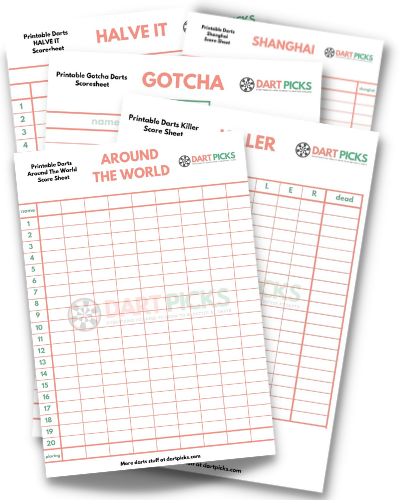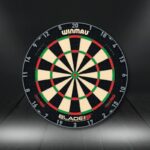The bullseye in darts is the small, innermost circle on the dartboard. It is worth 50 points. The green circular area surrounding the bullseye is known as the outer bull and is worth 25 points.
In soft tip darts, the entire center circular area is classed as the bullseye and worth 50 points.
It’s called a bullseye because it is believed early archers in England would use the skull of a bull and attempt to shoot through the eye of the bull as target practice.
Last update on 2025-12-23 / Affiliate links / Images from Amazon Product Advertising API
Table of Contents
How Many Points Is A Bullseye?
In steel tip darts the center red bullseye is worth 50 points and the outer green bull is worth 25 points. In soft tip darts, the entire red and green area (or equivalent) is worth 50 points.
Is the Bullseye a Double?
Yes, the center red area of the bull is counted as a double in ’01’ countdown games and can be used to check out or finish a game. If you have 50 points left you can hit the center bull and win the game.
However, the outer green area of the bull is classed as a single and cannot be used to check out.
Bullseye in Soft Tip Darts
The bullseye in soft tip darts is quite different from steel tip darts. Primarily because the entire area of the center circle is classed as a bullseye and worth 50 points. As this are is in fact larger than the triple 20 section, some soft tip dart players may opt to aim for the bull instead of triple 20 as:
- they find it more instinctive
- it’s only 10 points less than a triple 20 (which is worth 60 points)
- a larger surface area means more chance of success
Should I Aim For the Bullseye?
In steel tip darts the chances of hitting the bullseye are slim and should probably only be used if you are behind in a match and have nothing to lose – if you have the opportunity to check out on 50 then take it.
Otherwise, it’s likely not a good idea to use the bullseye.
However, as explained above, many soft tip players use the bullseye more often as the entire area counts as a double bull worth 50 points.
For more information on the tactics of hitting the bullseye check out this article –Why Don’t Dart Players Go For Bullseye?
What is the Most Difficult Checkout in Darts?
When playing 501 the most difficult way to achieve the perfect game and a 9 dart finish is to score the following:
- 3 × Triple 20 = 180
- 3 × Triple 19 = 171
- 3 × Bullseye 50 = 150
The triple bullseye is also known as that trick or Alan Evans shot. He famously finished on a triple bullseye in a Scottish exhibition match and the shot became named after him.
Using the Bullseye to Start a Game
In darts games like 501 the order of play is vital. If you get to go first, you get a chance at everything first and that includes finishing. For that reason when starting a game, the bullseye is used as a target to decide who goes first.
One dart from each player is thrown at the bull and the player closest gets to go first.
Tips on Hitting the Bullseye
The following are some tips to help you hit the bullseye more often:
- Buy a dartboard that has a staple free bullseye
- Secure a stable stance and only move your arm and shoulder when throwing
- Keep your forearm perpendicular
- Release the dart about 2/3 or the way into the throw
- Follow through pointing in the direction of the bull
Bullseye the TV Show
Those of you who have been around long enough (and in the UK) may remember the TV show ‘Bullseye‘ that was actually a quiz show with darts as the theme. In the 1980s darts was extremely popular in the UK and at their peak attracted 20 million viewers!
You can check out an episode here (though be warned as it hasn’t aged particularly well!):
In Summary
The bull is an important part of any dartboard. Although it may not often be used in competitive darts, it adds an element of extremely high skill to the game making it an exciting thrill for audiences if a player succeeds with a bullseye.
So there you have it – everything you need to know about the darts bullseye! Whether you’re a beginner or an experienced player, understanding the bullseye is crucial if you want to be successful. Practice makes perfect, so make sure you get plenty of time in at the dartboard and soon you’ll be nailing that bullseye every time.
You might also like 5 Darts Check Out Charts.
Sue has been playing darts since her 20’s when she played in weekly tournaments and she enjoys writing about darts. She’s also a great teacher, and she enjoys helping others learn how to play the game well. When Sue isn’t throwing darts, she enjoys spending time with her family and friends.
The easy way to keep track of your score is with our printable darts scoresheets. Easy to download and keep on your phone or computer or print straight off from our website. Pop your email address into the box and we'll send them straight to you.










